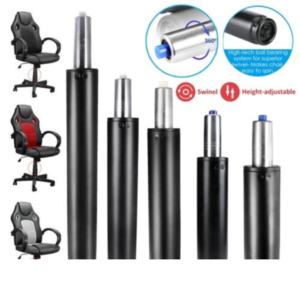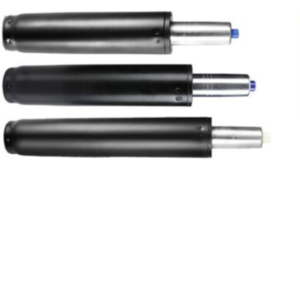Office chairs are an essential part of any workspace, providing the necessary support and comfort to enhance productivity. However, over time, many people face the frustrating problem of their office chair gradually sinking. This can disrupt your workflow and cause discomfort. In this article, we will explore why office chairs sink and provide practical solutions to fix the problem.
Why Do Office Chairs Sink?

Before we dive into the solutions, it’s essential to understand why office chairs sink. Most office chairs use a pneumatic cylinder (also known as a gas lift) to adjust the height. This cylinder is filled with pressurized gas that enables smooth movement up and down. Over time, the seal inside the cylinder can wear out or break, causing the gas to escape. Consequently, the chair loses its ability to hold pressure, leading to the sinking issue.
What to do when office chairs sink?
Immediate Temporary Fixes
While waiting for a permanent solution, you can use some temporary fixes to keep your chair at the desired height. These solutions might not be long-term but can provide a quick relief.
1. Use a Hose Clamp
- Step 1: Slide the plastic skirt off the cylinder to expose the metal part.
- Step 2: Adjust the chair to the desired height.
- Step 3: Wrap a hose clamp around the metal cylinder, just below the chair mechanism.
- Step 4: Tighten the clamp to hold the chair in place.
2. Use a PVC Pipe
- Step 1: Measure the cylinder’s diameter.
- Step 2: Purchase a PVC pipe that fits snugly over the cylinder.
- Step 3: Cut the pipe to the length needed to maintain the desired height.
- Step 4: Slide the pipe over the cylinder to support the chair at the correct height.
These quick fixes can help you maintain your chair’s height temporarily, but for a more durable solution, you’ll need to address the underlying issue.
Permanent Solutions for office chairs that sink
To permanently fix your sinking office chair, you’ll need to either replace the faulty gas cylinder or use an alternative solution. Here are some steps to guide you:

1. Replace the Gas Cylinder
- Step 1: Purchase a replacement gas cylinder that matches your chair’s specifications. You can find these online or at office supply stores.
- Step 2: Remove the old cylinder. First, remove the base of the chair. This usually involves removing a retaining clip and sliding the base off.
- Step 3: Use a pipe wrench to twist and pull the old cylinder out of the chair mechanism.
- Step 4: Insert the new cylinder into the chair mechanism. Secure it by reattaching the base and any clips or screws.
- Step 5: Test the chair to ensure it adjusts correctly and holds its height.

Replacing the gas cylinder can restore your chair to like-new condition, providing long-lasting support and comfort.
2. Install a Chair Saver Kit Another permanent solution is to use a chair saver kit, which provides an adjustable height lock mechanism.
- Step 1: Purchase a chair saver kit compatible with your chair model.
- Step 2: Follow the instructions provided with the kit to attach the locking mechanism to the gas cylinder.
- Step 3: Adjust the height and lock the mechanism in place.
This solution is less invasive than replacing the entire cylinder and can extend the life of your chair.
Preventive Maintenance Tips for office chairs that sink
Once you’ve fixed your chair, it’s crucial to maintain it properly to prevent future issues. Here are some maintenance tips to keep your office chair in good condition:
1. Regularly Clean and Inspect
- Dust and debris can accumulate in the chair’s mechanisms. Regularly clean your chair, especially around the moving parts, to ensure smooth operation.
- Inspect the gas cylinder and other mechanisms for signs of wear and tear. Address any issues promptly to prevent further damage.
2. Lubricate Moving Parts
- Apply lubricant to the moving parts of the chair, such as the gas cylinder and tilt mechanism, to ensure smooth movement and reduce wear.
3. Avoid Overloading
- Respect the weight limit of your office chair. Overloading can strain the gas cylinder and other components, leading to premature wear.
4. Adjust Properly
- Make sure to adjust your chair correctly according to your body size and desk height. Improper adjustments can cause strain on the chair’s mechanisms.
When to Replace Your Office Chair
Despite your best efforts, there might come a time when it’s more practical to replace your office chair rather than repair it. Here are some signs that it’s time for a new chair:

1. Excessive Wear and Tear
- If your chair shows significant signs of wear, such as torn upholstery, broken parts, or an unstable base, it might be time for a replacement.
2. Lack of Support
- Over time, the cushioning and support in your chair can degrade, leading to discomfort and poor posture. If your chair no longer provides adequate support, consider investing in a new one.
3. Repeated Issues
- If your chair continues to have problems despite multiple repairs, it may be more cost-effective to replace it with a new, reliable model.
Choosing a New Office Chair

When it’s time to buy a new office chair, consider the following factors to ensure you choose the best option for your needs:
1. Ergonomics
- Look for chairs with ergonomic features, such as adjustable seat height, lumbar support, and armrests. These features can enhance comfort and reduce the risk of musculoskeletal issues.
2. Material and Build Quality
- Choose a chair made from high-quality materials, such as durable fabric, leather, or mesh. A sturdy build ensures longevity and reliability.
3. Weight Capacity
- Make sure the chair’s weight capacity matches your needs to ensure it can support you comfortably and safely.
4. Budget
- Office chairs come in a wide range of prices. Determine your budget and look for a chair that offers the best combination of features and quality within your price range.
5. Warranty
- Check the warranty offered by the manufacturer. A good warranty can provide peace of mind and protect your investment.
Conclusion
Dealing with office chairs that sink can be frustrating, but with the right knowledge and tools, you can fix the issue and restore your chair’s functionality. Temporary fixes like using a hose clamp or PVC pipe can provide quick relief, while permanent solutions such as replacing the gas cylinder or installing a chair saver kit offer long-lasting results.
Additionally, preventive maintenance can help extend the life of your chair and keep it in good working condition. If your chair shows significant signs of wear, lacks support, or has repeated issues, it might be time to invest in a new, high-quality office chair.
Choosing a new chair with ergonomic features, durable materials, and a suitable weight capacity ensures you stay comfortable and productive in your workspace. By following these tips, you can enjoy a well-supported and stable seating experience, whether you’re working from home or in the office.
